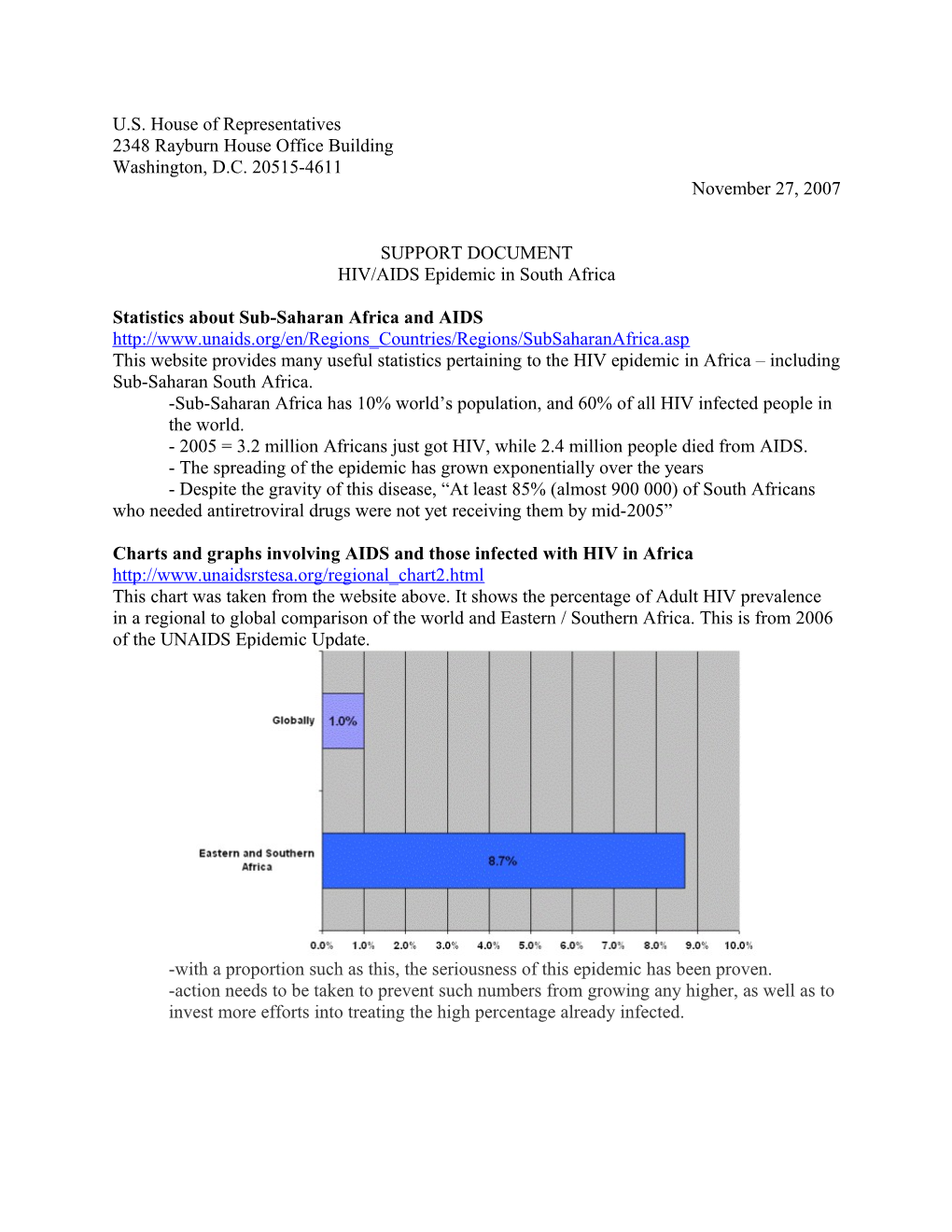U.S. House of Representatives
2348 Rayburn House Office Building
Washington, D.C. 20515-4611
November 27, 2007
SUPPORT DOCUMENT
HIV/AIDS Epidemic in South Africa
Statistics about Sub-Saharan Africa and AIDS
This website provides many useful statistics pertaining to the HIV epidemic in Africa – including Sub-Saharan South Africa.
-Sub-Saharan Africa has 10% world’s population, and 60% of all HIV infected people in the world.
- 2005 = 3.2 million Africans just got HIV, while 2.4 million people died from AIDS.
- The spreading of the epidemic has grown exponentially over the years
- Despite the gravity of this disease, “At least 85% (almost 900 000) of South Africans who needed antiretroviral drugs were not yet receiving them by mid-2005”
Charts and graphs involving AIDS and those infected with HIV in Africa
This chart was taken from the website above. It shows the percentage of Adult HIV prevalence in a regional to global comparison of the world and Eastern / Southern Africa. This is from 2006 of the UNAIDS Epidemic Update.
-with a proportion such as this, the seriousness of this epidemic has been proven.
-action needs to be taken to prevent such numbers from growing any higher, as well as to invest more efforts into treating the high percentage already infected.
The following chart provides a regional global comparison of AIDS related deaths which were taken from the year of 2006 as well. This was also from the UNAIDS Epidemic Update, too.
-When aligning up the regional vs. global AIDS related death count, it really puts the problem into perspective
-AIDS is spreading at an alarming rate
-The primary areas to concentrate efforts of stopping the disease is South Africa (East Africa has a large percentage too, but South Africa’s is much larger even though it is not necessarily shown in this specific graph.
This data was taken from 2005 results of the amount of ARVs (Antiretroviral drugs) given to HIV infected Africans based off of individual regions.
-3 out of 16 countries achieved the “3 by 5 target”
-Only 7 countries received at least 20% treatment coverage
-If you notice, S. Africa only achieved 21% treatment coverage when they are the most HIV infected country out of all of them. While fortunate countries like Mauritus, Botswana, and Uganda received more than half of treatment coverage, more effort should be concentrated on the Sub-Saharan countries to up their numbers too.
Patents on drugs – HIV, AIDS, and malaria – ethical issues in third world countries
-Drug patenting plays a major role and issue with giving ARVs to HIV South Africans
- Regulation 816/2006 of European Commission enforces the provisions of the Doha declaration making it legal in the EU and Canada.
-Says compulsory licenses should be issued in developed countries to make patented drugs on condition that they’re sent to third world countries with incomes less than $745 US dollars a year.
-Generally not enough of a certain patented drug on the market due to poor estimates of supply and demand, as well as high costs.
-“The issue of compulsory licenses allows the number of manufacturers to be increased, thereby allowing greater volumes of supplies to be manufactured.”
-More on compulsory licenses
-Definition:
-“In a compulsory license, a government forces the holder of a patent, copyright, or other exclusive right to grant use to the state or others. Usually, the holder does receive some royalties, either set by law or determined through some form of arbitration.”
-Problems with them?
-TRIPs (The Agreement on Trade-Related Aspects of Intellectual Property Rights). TRIPs allow compulsory licenses to be given to third world countries
-Countries given license often do not have the means to manufacture drugs on their own – this is where the U.S. should come in and help! But TRIPs requires that compulsory licenses be used locally only, so I’s not possible to make the drugs overseas and import them where they’re needed.
-More on TRIPs
-“A natural concern is that the TRIPS agreement will be one more hurdle preventing the production or importation of widely needed drugs into regions with high burdens of HIV/AIDS.”
-“Unless exemption legislation is included in national laws, there will be no means for countries to override patent protection”
-“The United Nations Development Programme's 2000 report says TRIPs are damaging because it “tightens patent and copyright protection, favoring those who develop and market technology rather than society's interest in liberal diffusion of new technology”
-Brings up question of what’s more important? Protecting knowledge or public health?
Problems with drug treatment and drug manufacturing
-The issue?
-Drugs for treatment are too expensive
-Costly to manufacture drugs to begin with
-“The main barriers to access are obvious: high drug prices and lack of local resources to pay for expensive treatment. VSO recommends that pharmaceutical companies and national governments consider how they might create both a sustainable program of drug donation and a fair system that takes account of the unmet needs of poor people.”
-ARV costs
-Western costs = $10,000 to $15,000 pppy
-Why so expensive?
-Patents and patent costs, funding for future research, desire for profit with drug companies, etc.
-African countries offer ARVs under $140 pppy
-That seems cheap, so why’s there a problem?
-Africans below poverty threshold (big percentage of the population, and big percentage of HIV infected people) only earn about $2 a day in income, making even that sum amount too expensive.
Specific Bills to Support
-S. 805: African Health Capacity Investment Act of 2007
-Amendment to Foreign Assistance Act of 1961
-Give assistance in preventing and treating HIV/AIDS in Sub-Saharan Africa.
-Improve Sub-Saharan African healthcare to fight mortality rate
-H.R. 1225: Focus on Family Health Worldwide Act of 2007
-Amendment to Foreign Assistance Act of 1961
-Aim to improve family planning abroad
-S. 569: Vaccines for the Future Act of 2007
-Advocates developing vaccines for illnesses affecting areas abroad
